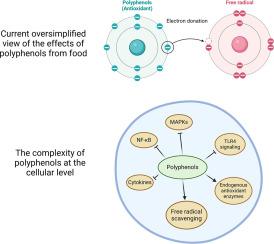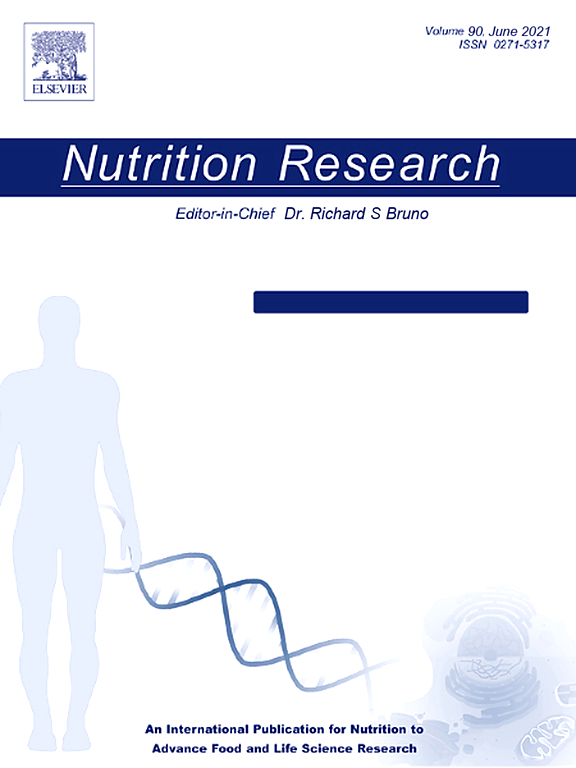在 RAW264.7 巨噬细胞样细胞中,多酚在 Toll 样受体 4 介导的炎症中具有不同于抗氧化功能的独特细胞效应
IF 3.4
3区 医学
Q2 NUTRITION & DIETETICS
引用次数: 0
摘要
植物多酚是一种生物活性化合物,因其具有抗氧化作用而备受推崇,这通常是解释其健康益处的主要属性。然而,我们假设多酚具有独立于抗氧化功能的分子特性。本研究的目的是调查与纯抗氧化剂相比,多酚是否具有独特的分子效应。用超氧化物清除剂 TEMPOL、羟自由基和过氧化氢清除剂 N-乙酰半胱氨酸或黑莓、蓝莓、覆盆子、草莓、羽衣甘蓝和巴豆中的多酚提取物对 RAW 264.7 巨噬细胞进行预处理。预处理 1 小时后,用脂多糖(100 毫微克/毫升)处理细胞 6 小时。抗氧化剂和多酚提取物在体外产生了抗氧化作用;然而,多酚以一种独特的保护性方式调节氧化还原蛋白,而抗氧化剂、TEMPOL和N-乙酰半胱氨酸则没有。此外,在下游 Toll 样受体 4 信号传导和炎症蛋白转录活性方面也观察到了不同的效果。我们得出结论:多酚具有独特的分子效应,而这些效应并不局限于其清除自由基的能力。这项研究加深了我们对多酚如何作用于炎症的分子认识。本文章由计算机程序翻译,如有差异,请以英文原文为准。

Polyphenols have unique cellular effects that are distinct from antioxidant function in Toll-like receptor 4–mediated inflammation in RAW264.7 macrophage-like cells
Plant polyphenols are bioactive compounds touted for their antioxidant effects, and this is often the primary attribute used to explain their health benefits. However, we hypothesize that polyphenols have molecular properties independent of antioxidant function. The objective of this study was to investigate whether polyphenols had distinct molecular effects compared to pure antioxidants. RAW 264.7 macrophages were pretreated with either TEMPOL, a superoxide scavenger, N-acetyl cysteine, a hydroxyl radical and hydrogen peroxide scavenger, or polyphenol extracts from blackberry, blueberry, raspberry, strawberry, kale, and baru nut. After 1 hour of pretreatment, cells were treated with lipopolysaccharides (100 ng/mL) for an additional 6 hour. Antioxidants and polyphenol extracts elicited antioxidant effects in vitro; however, polyphenols regulated redox proteins in a distinct, protective manner, whereas antioxidants, TEMPOL, and N-acetyl cysteine, did not. Additionally, distinct effects were observed in downstream Toll-like receptor 4 signaling and transcriptional activity of inflammatory proteins. We conclude that polyphenols have unique molecular effects that are independent of just their free radical scavenging capacity. This work advances our molecular understanding of how polyphenols act to target inflammation.
求助全文
通过发布文献求助,成功后即可免费获取论文全文。
去求助
来源期刊

Nutrition Research
医学-营养学
CiteScore
7.60
自引率
2.20%
发文量
107
审稿时长
58 days
期刊介绍:
Nutrition Research publishes original research articles, communications, and reviews on basic and applied nutrition. The mission of Nutrition Research is to serve as the journal for global communication of nutrition and life sciences research on diet and health. The field of nutrition sciences includes, but is not limited to, the study of nutrients during growth, reproduction, aging, health, and disease.
Articles covering basic and applied research on all aspects of nutrition sciences are encouraged, including: nutritional biochemistry and metabolism; metabolomics, nutrient gene interactions; nutrient requirements for health; nutrition and disease; digestion and absorption; nutritional anthropology; epidemiology; the influence of socioeconomic and cultural factors on nutrition of the individual and the community; the impact of nutrient intake on disease response and behavior; the consequences of nutritional deficiency on growth and development, endocrine and nervous systems, and immunity; nutrition and gut microbiota; food intolerance and allergy; nutrient drug interactions; nutrition and aging; nutrition and cancer; obesity; diabetes; and intervention programs.
 求助内容:
求助内容: 应助结果提醒方式:
应助结果提醒方式:


